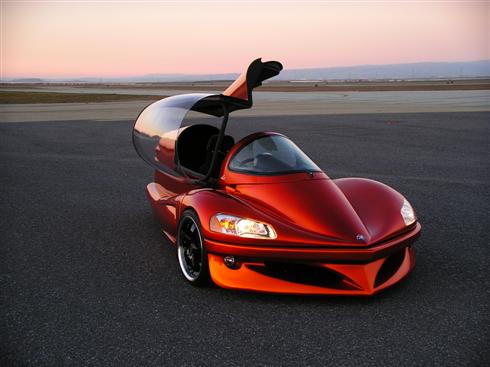By Evan Ackerman

Yesterday I wrote about an Air Powered car, and based on the, uh, popularity of that post (which I will address in due course), here’s another type of vehicle that uses air to increase fuel efficiency. The new tech under the hood is called Fuel Vapor, and it’s able to increase the fuel efficiency of any gas engine by up to 20% while at the same time decreasing CO2 emissions by 30%, all without a catalytic converter. This is all apparently made possible by mixing air with fuel at a ratio of 20:1, as opposed to 14.7:1, which is standard for most cars.
Although the Fuel Vapor system can be installed on any gas engine, it’s flagship platform, the alé (that would be “allay,” not “ale”), is no slouch. The alé has a 180hp Honda engine and can accelerate from 0 to 60 in 5 seconds, with an electronically limited top speed of 140 mph. It corners at 1.7g on street tires, and at 92 mpg, can drive from Canada so San Francisco without refueling. Furthermore, it emits 75% less CO2 than your average hybrid. The initial run of these cars will be hand built and cost $75,000 (Canadian), with mass production predicted to bring the price down to less than half that in 5 years. A video, and more commentary, after the jump.
[ Evan’s commentary will make a lot more sense to you if you take the time to read the comments left on his previous “Air Car” article. -Ed. ]
Now, Fuel Vapor technology doesn’t approach the levels of cleanliness and efficiency that the Air Car claims to, but the upside is (and it’s a big upside due to sheer convenience) that it runs on normal gasoline and you can refuel it anywhere. As such, it’s certainly no solution to our oil dependency, but it’s a step in a positive (if perhaps not ultimately the best) direction.
So then, what’s the best direction? In my opinion, we’re shooting for safe, zero emissions vehicles, driven by energy from renewable sources. I am immensely in favor of this, and indeed, in favor of any steps (however small) in this direction. That being said, I think it’s important that each step taken is carefully thought out, and in our current media saturated (read: media biased) world, the consumer has to do a lot of that analysis on their own. The Air Car, for example, is undeniably a very environmentally friendly vehicle in that it runs on air, producing zero emissions. But at the same time, it raises questions that both the media (since environmentalism is so popular) and the manufacturer (for obvious reasons) seem reluctant to directly address… For example, where is the power to compress the air coming from, and how environmentally friendly is that? From a more general perspective, do we want to try and centralize our power production for maximum efficiency, even if it means depending more heavily on an aging and overworked power grid? Or would we rather decentralize into smaller regional or even personal means of renewable power production, even if they are significantly more expensive and potentially less reliable?
Questions like these are just the tip of the iceberg, and I don’t mean to try and answer them myself (don’t worry). The point I am attempting to make (and that perhaps I failed to make clearly in a certain previous post) is that these are complicated issues, and it’s far too easy to just say “wow, a car that runs on air!” and leave it at that (which is what mainstream media tends to do). There are no easy answers, and there may not even be “correct” answers, but companies like FuelVapor and MDI are making substantial progress in a positive direction and deserve not only superficial publicity, but also well thought out and carefully reasoned support.
[ FuelVapor Technologies ] VIA [ Driving.ca ]










